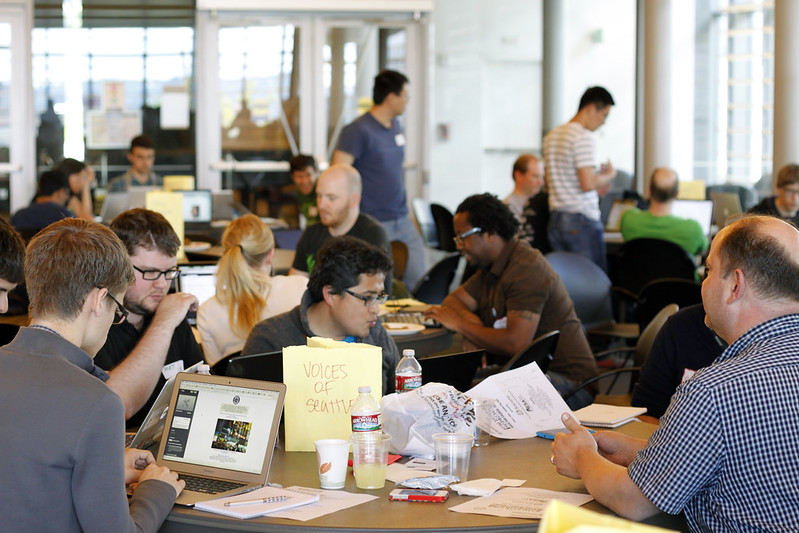How can we make planning more open and inclusive? Inspired by a cat poster, SeattleMonkeys asks community residents to call a number to share their ideas on local affairs and transportation.
This summer, I’m in Seattle as an intern for Microsoft research FUSE Labs with Andrés Monroy-Hernández (whose work on Scratch I have blogged about) and Shelly Farnham. I’ll write soon about my summer at Microsoft, but this is a story about what Andrés and I did together on the weekend, outside of our Microsoft work.
Hack 4 Change Seattle was a remarkable gathering of other community members and makers at the Seattle City Hall, part of the US wide National Day of Civic Hacking. You can read more about projects created at Hack 4 Change Seattle in the post I wrote for Code for Seattle.
Seattle Monkeys was created by an awesome team in just four hours. Read on to learn more about how we did it. Great work, Andrés Monroy Hernandez, Gilberto Stankiewicz, Elijah Rotholtz, Matt Loar, and Alex Swan!

Learning from Cat Posters
Andrés first imagined voice community feedback after noticing that an important Seattle consultation was being held at 3pm in the afternoon– a time when most people aren’t able to attend because they’re at work. He also started to take pictures of public notifications found along his commute:
The cat poster has is the best design of all three. It’s visually arresting, has a simple narrative, and offers an easy call to action: call this number if you see the cat. Could we make public consultation as easy to read and respond as the average cat poster?
Voice Publishing
Digital platforms for voice publishing and petitions have a rich heritage. Just within the MIT Media Lab, Aaron Zinman and Greg Elliot’s Konbit project combined voice with crowdsourcing to manage a jobs board in Haiti. Leo Burd has created a series of voice based community projects, including VOIP Drupal and What’s Up. Chris Csikszentmihlyi supported projects within his Call 4 Action class, including this project in Mexico to collect flu data via sms. More recently, The Center for Civic Media has created VOJO.co, a powerful and usable system to create and publish media from phones. Catherine D’Ignazio has been doing remarkable work on voice petitions for the Erase the Border campaign and her work at the White House Hackathon.
The SeattleMonkeys Experience
The SeattleMonkeys experience is simple. Each neighbourhood has a special phone number for residents to call. Posters in that neighbourhood ask a simple question, such as “I love Ballard because…” or “My commute would be better if…” When participants call in, a voice explains the project and what to expect and invites them to leave a message. That message is transcribed, uploaded to Soundcloud and published to a Tumblr post. That post is shared out to the SeattleMonkeys Twitter account and the SeattleMonkeys Facebook page.
How SeattleMonkeys Works
Our team of five was able to make this service in four hours by using a series of highly interoperable technology platforms. At least half of time time involved creating strategies that required us to write the minimum possible amount of new code. Phone numbers and voice messages are accepted via Twilio. A custom Python script by Matt Loar listens to the Twilio API and uploads new messages directly to the audio hosting service SoundCloud. We configured SoundCloud to post automatically to Tumblr, and Tumblr to post automatically to Facebook and Twitter. In principle, the Python script could be modified to post SMS messages directly to Tumblr as well.
Effective Voice Campaigns
Over the next few weeks, our team plans to put up posters and find out what community members have to say about our neighborhoods. But to be a meaningful petition, campaign, or publishing platform, SeattleMonkeys would need weeks of conversation and collaboration with existing organisations in the communities we’re trying to serve. At the Center for Civic Media, our codesign facilitator and community organiser Becky Hurwitz does amazing work to make sure that the technologies we create have community involvement from the start.
In four hours, our team was able to make a complete design, together with an outreach campaign and a plan for local deployment. That’s amazing, and we owe a lot of thanks to the organisers of Seattle Hack 4 Change as well as everyone on the team for all your amazing work. That’s not enough. We hope that Seattle Monkeys helps organisations in the city see how easy (and inexpensive) it can be to include voice feedback in organising and consultation.
Keeping in mind that hackathons alone don’t solve problems, we’re eager to find neighborhoods and communities that want to continue the conversation to find and use technologies that can be part of larger campaigns to broaden public inclusion in planning and community feedback.





